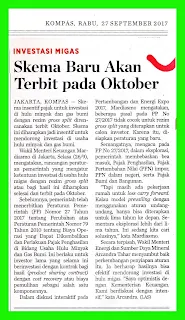PT Pertamina through its subsidiary, PT Pertamina EP Cepu (PEPC) will issue an investment fund worth 1.547 billion US dollars or Rp 20.46 trillion for the Jambaran-Tiung Biru Gas Fieldization (JTB) field project. Investment in projects that are part of the national strategic project is expected to provide a multiplier effect for the national economy.
President Director of PT Pertamina Elia Massa Manik explained that the development of Jambaran-Tiung Biru will be a new hope for Indonesia, especially to overcome the gas supply deficit in Central Java and East Java. With JTB gas reserves of 2.5 trillion cubic feet (TCF) Pertamina expects the industries in Central Java and East Java to have sufficient gas supply to drive the national economy.
"The development of the JTB field will also create employment directly and indirectly and in turn will reduce the poverty rate which is one of President Joko Widodo's priority programs," Massa said in Bojonegoro, Monday (25/9).
Currently, according to Massa, Pertamina is still completing the negotiation of the transfer of participating interest (PI) in the development of JTB. Pertamina now has a 45 percent PI. However, after managing it, Pertamina will control PI up to 91 percent and the remaining nine percent will be owned by regionally owned enterprises (BUMD).
Along the process of negotiation, has been a lot of progress achieved JTB project. Progress is among others the achievement of a gas purchase agreement with PT PLN at a price of 7.6 US dollars per Million Metric British Thermal Unit (MMBTU) on August 8, 2017.
"The agreement was the beginning to be able to develop gas field JTB, because there are already buyers," said Massa.
Massa later explained that JTB field has a high complexity with 34 percent CO2 content, 330 million cubic feet per day gas processing facility (MMSCFD), and gas selling 172 MMSCFD. The pod project will begin drilling after PEPC appointed PT Rekayasa Industri (Rekind) and PT Japan Gas Corporation which has won the tender. "
Massa also added that currently, Pertamina through its subsidiary, PT Pertamina Gas (Pertagas) is completing the construction of 267 kilometers of Gresik-Semarang pipeline with investment value of approximately 515.7 million US dollars or Rp 6.70 trillion
"With EPC progress now reaching 85 percent, it is estimated that this project will be onsntream in the middle of 2018," said Massa.
President Director of PT Pertamin EP Cepu (PEPC) Adriansyah confirmed that the JTB gas field development project project will have a multiplier effect for the local community. That is none other than because the project will absorb about 6,000 local workers at the peak of the project.
"The JTB project will employ 6,000 local workers in Bojonegoro and surrounding areas. Our commitment to contribute to boost the regional economy is by creating jobs for local communities," Adriansyah said.
Adriansyah added, indeed for early civil work (ECW), currently there are only about 200 unskill labor in the project. However, as more work on JTB projects will be built in the future, local labor needs will also increase.
IN INDONESIA
Pertamina Alirkan Rp 20,46 Triliun Untuk JTB
PT Pertamina melalui anak perusahaan, PT Pertamina EP Cepu (PEPC) akan mengeluarkan dana investasi senilai 1,547 miliar dolar AS atau Rp 20,46 triliun untuk proyek unitisasi Lapangan Gas Jambaran-Tiung Biru (JTB). Investasi terhadap proyek yang merupakan bagian proyek strategis nasional tersebut diharapkan dapat memberikan multiplier effect bagi ekonomi nasional.
Direktur Utama PT Pertamina Elia Massa Manik menjelaskan, pengembangan Jambaran-Tiung Biru akan menjadi harapan baru bagi Indonesia, khususnya untuk mengatasi defisit pasokan gas di Jawa Tengah dan Jawa Timur. Dengan cadangan gas JTB sebesar 2,5 triliun kaki kubik (TCF) Pertamina berharap industri di Jawa Tengah dan Jawa Timur akan mendapat suplai gas yang cukup menggerakkan ekonomi nasional.
"Pengembangan lapangan JTB juga akan membuka lapangan kerja secara langsung maupun tidak langsung dan pada gilirannya akan mengurangi angka kemiskinan yang menjadi salah satu program prioritas Presiden Joko Widodo," kata Massa di Bojonegoro, Senin (25/ 9).
Saat ini, menurut Massa, Pertamina masih terus menuntaskan negosiasi pengalihan hak partisipasi (participating interest/PI) dalam pengembangan JTB. Pertamina kini memiliki PI 45 persen. Namun, setelah alih kelola, Pertamina akan menguasai PI hingga 91 persen dan sisanya sembilan persen akan dimiliki badan usaha milik daerah (BUMD).
Seiring proses negoisasi tersebut, telah banyak kemajuan diraih proyek JTB. Kemajuan yang dimaksud antara lain tercapainya kesepakatan jual beli gas bumi dengan PT PLN dengan harga 7,6 dolar AS per Million Metric British Thermal Unit (MMBTU) pada 8 Agustus 2017.
"Kesepakatan itu menjadi awal untuk bisa mengembangkan lapangan gas JTB, karena sudah ada pembelinya," ujar Massa.
Massa kemudian menjelaskan, lapangan JTB memiliki kompleksitas tinggi dengan kandungan CO2 34 persen, fasilitas pemrosesan gas 330 juta kaki kubik per hari (MMSCFD), dan produksi gas jual 172 MMSCFD. Adapun pod proyeknya akan dimulai pengeborannya setelah PEPC menunjuk PT Rekayasa Industri (Rekind) dan PT Japan Gas Corporation yang sudah memenangkan tender."
Massa juga menambahkan, saat ini, Pertamina melalui anak perusahaan, PT Pertamina Gas (Pertagas) sedang menyelesaikan pembangunan pipa Gresik-Semarang sepanjang 267 kilometer dengan nilai investasi sekitar 515,7 juta dolar AS atau Rp 6,70 triliun
"Dengan progres EPC saat ini sudah mencapai 85 persen, diperkirakan proyek ini akan onsntream pada per-tengahan tahun 2018," kata Massa.
Direktur Utama PT Pertamin EP Cepu (PEPC) Adriansyah memastikan proyek proyek pengembangan Lapangan gas JTB akan memiliki multiplier effect bagi masyarakat setempat. Itu tidak lain karena proyek tersebut akan menyerap sekitar 6.000 pekerja lokal pada masa puncak proyek.
"Proyek JTB akan mempekerjakan 6.000 tenaga lokal di Bojonegoro dan sekitarnya, Komitmen kami untuk bisa berkontribusi mendorong perekonomian daerah salah satunya adalah dengan menciptakan lapangan kerja bagi masyarakat setempat,” kata Adriansyah
Adriansyah menambahkan, memang untuk early civil work (ECW), saat ini baru saja terdapat sekitar 200 orang unskill labour dalam proyek tersebut. Namun, sejalan dengan makin padatnya pengerjaan proyek JTB di masa mendatang, kebutuhan tenaga kerja lokal juga akan semakin meningkat.
Republika, Page-19, Tuesday, Sept 26, 2017










